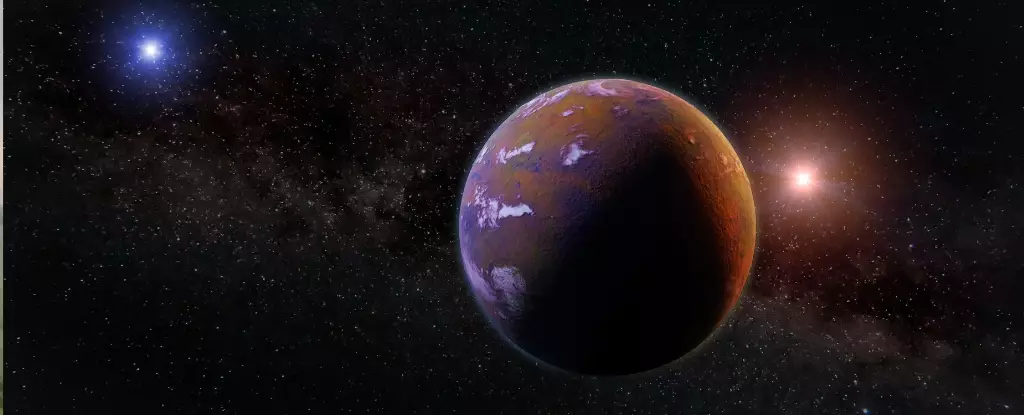The cosmos constantly challenges our understanding of how planets emerge, evolve, and interact with their stellar environments. Traditionally, the process of planet formation was thought to occur exclusively within protoplanetary disks—vast, swirling structures of gas and dust encircling young stars. But recent discoveries reveal a much more intricate picture, where the lifespans and characteristics of these disks vary significantly depending on stellar conditions. This nuanced understanding underscores a vital shift: not all stars follow the same planetary timeline, and some may hold secrets missed by conventional observation methods.
The recent direct imaging of a planet orbiting a star that has seemingly “cleared out” its disk exemplifies this evolution in thought. While protostellar environments with rich disks are ripe hunting grounds for new worlds, the absence of a disk shouldn’t be seen as an end to planet-hunting. Instead, it opens unique opportunities to detect planets that have already formed but are otherwise concealed within dust-laden environments. Such insights challenge prior assumptions and expand our horizons toward a more comprehensive understanding of planetary genesis.
Binary Systems: Natural Laboratories for Planet Formation Diversity
The star system HD 135344 AB demonstrates a fascinating divergence in planetary developmental stages within a single binary configuration. The primary star, classified as an A-type main-sequence star, has effectively shed its protoplanetary disk, revealing the possibility that planet formation here has largely concluded. Meanwhile, its companion, an F-type star still actively accreting material and hosting a vibrant disk, continues the process of planetary assembly. This juxtaposition is unprecedented and offers a natural experiment—highlighting that even stars in close proximity can have vastly different evolutionary timelines.
This disparity underscores the importance of studying binary systems. Such systems reveal that planet formation is not a monolithic process but a variable phenomenon sensitive to multiple factors like stellar mass, radiation output, and environmental influences. The primary star’s lack of dust may be a sign of advanced maturation in planetary formation, or perhaps the result of energetic processes like photoevaporation gradually dispersing the disk. Conversely, the secondary star’s dense, feature-rich disk remains an active site for planet assembly, providing us with critical snapshots into different phases of planetary evolution within the same stellar neighborhood.
Detection Triumphs and the Power of Cutting-Edge Instruments
The real breakthrough in this domain stems from technological innovation—particularly instruments capable of piercing through cosmic dust to directly image exoplanets. The Very Large Telescope (VLT), equipped with the SPHERE instrument, represents a pinnacle of observational engineering. Its capacity to resolve faint objects close to bright stars has rewritten the rules of exoplanet detection, especially for young, luminous giants orbiting at relatively close distances.
The detection of HD 135344 Ab, a young, massive planet orbiting just 15-20 astronomical units from its star, is a testament to the power of such tools. After four years of meticulous observation, the researchers obtained compelling direct images—solid evidence of a planet rather than an artist’s interpretation or inference based on indirect data. This achievement is significant because it confirms the presence of a planetary body in a region where previous techniques struggled, especially given the planet’s proximity to its star and the crowded, dusty environment.
Importantly, these images were not simply aesthetically pleasing; they provided critical data about the planet’s mass, orbit, and likely formation process. The planet’s estimated 10 Jupiter masses and location near the snow line—a region where icy solids enable rapid planet formation—offer profound clues about how and where giant planets form. In effect, this detection represents a milestone, proving that direct imaging can be refined enough to locate and characterize worlds in challenging environments.
Implications for Planet Formation Models and Future Exploration
This discovery feeds into a broader debate about the mechanisms behind planet formation, especially in binary systems. The close proximity of the planet to its star and its position near the snow line bolster the core accretion model, where dust and ice coalesce over time to form planetary cores that eventually attract gas envelopes. The properties of HD 135344 Ab suggest that the earliest stages of giant planet formation are more dynamic and perhaps more common in the universe than previously thought.
Furthermore, the detection underscores the importance of precise astrometry—allowing astronomers to differentiate between background stars and genuine planet companions. The combination of Gaia mission data and advanced ground-based telescopes exemplifies the synergy needed to confirm and understand these distant worlds. The discovery hints that many young, close-in giant planets may have eluded detection because conventional methods lacked the resolution or timing to catch them at opportune moments in their orbital dance.
Looking ahead, the next decade promises a leap forward. The imminent launch of the Extremely Large Telescope (ELT) in 2029 heralds a new age of observational capability. With its unprecedented size and advanced instruments, the ELT will delve deeper into planetary systems, characterizing atmospheres and compositions in greater detail. It will unearth the diversity of planets that current telescopes can only hint at, fundamentally transforming our understanding of planetary origins and the timescales involved.
The ongoing quest to detect and study young planets like HD 135344 Ab not only challenges preexisting notions but also invigorates the field with optimism. As new technologies emerge and our observational strategies become more refined, the universe’s hidden worlds will become clearer, revealing the astonishing variety and complexity of planet formation—a narrative still being written, one discovery at a time.

